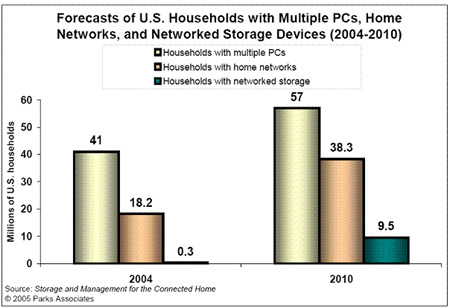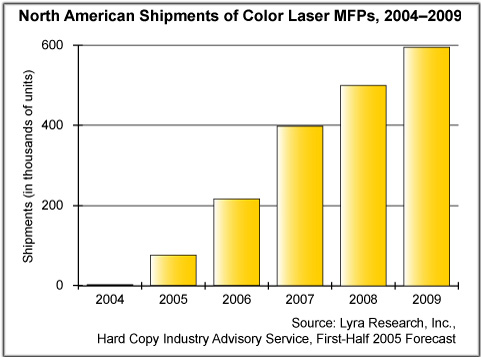Digital Technology Market Digest
September 20 2005
Digital technology is everywhere - three sets of surveys results released this week illustrate the growth of networked entertainment and storage devices and of color laser MFPs in the US. However, it can sometimes get ahead of consumers, as shown by a survey of UK digital TV subscribers.
A report from InfoTrends/CAP Ventures says the market for multimedia home networks (those containing A/V devices) is still in its infancy. While nearly 20% of US households have a data home network, less than 5% currently have a multimedia network such as one with a television or stereo connected to the network. However, the growth of digital cameras, camcorders, PVRs, and MP3 players should combine with lower-cost networking technologies to give the market a kick-start in the near future.
The report says that systems based on a central server sending and receiving content to a number of devices may predominate. Devices include PC, stereo, or TV and the central server could be a PC or a dedicated media server/set-top box - manufacturers of each type of equipment will be competing to establish theirs as the norm.
'Consumers are accumulating digital media files at a rapid clip, making multimedia networks even more desirable' according to Director Mike Wolf. 'Now is the time for vendors to stake their claims as new possibilities unfold'. The Digital Domicile: Digital Entertainment in the Home and the Impact of Multimedia Networks also profiles key industry players and gives a five-year forecast for PC-based home networks and media networks.
A report from Parks Associates addresses the same area, forecasting that the number of US households with a networked storage device will grow from 300,000 at the end of 2004 to nearly 10 million by 2010. Storage and Management for the Connected Home says such devices will be marketed to households with home networks and those with multiple PCs. By 2010, it predicts that 17% of US households with multiple PCs and one-fourth of those with a home network will have a networked storage device.

Senior Analyst Yuanzhe (Michael) Cai says that once consumers 'realize the danger of losing their valuable digital assets to hard drive crashes, virus attacks, or other uncontrollable events' they are in the market for 'a robust backup solution. For households with multiple PCs or a home network, a centralized storage that can be shared among multiple platforms makes a lot of sense'. He estimates sales of 400,000-600,000 units in 2005.
Other drivers for this growth include falling prices, market entry and consumer awareness campaigns by major hard drive and home networking companies, better software and new system-on-a-chip solutions.
Many consumers are likely to remain bemused, however, by talk of losing their digital assets. Existing technology is often under-used, as an
Ipsos DART survey of UK digital subscribers reveals. Just under a third say they have never used interactive TV or enhanced programming, with nearly half citing 'sheer lack of interest' as the reason, according to the latest quarterly survey, run by Ipsos Media.
iTV remains primarily an information service in the eyes of users - getting them to actually
purchase this way is difficult. 39% of those using iTV claimed they used it to source news or weather reports, 23% to look up sports results and 16% to access holiday information, but only 1% are purchasing their trip through it.
Other factors holding back adoption are fears over credit card misuse - the number of people 'very concerned' about giving out their credit card details rose from 59% to 63% in the last quarter - and the nuisance of interrupting viewing when pressing the red button.
David Lucas, Senior Director of Ipsos Media, says broadcasters should take note and can address some of the reasons for which people remain skeptical of interactive features: 'Issues such as financial security and convenience of use must be addressed before viewers will start to embrace the services on offer'.
The number of households using enhanced programming has remained the same since January 2005, with 48% saying they have pressed the red button when watching or just having finished watching TV programmes. Among the key programmes during which it is used: 7% of those pressing the red button did so during the FA cup, and 15% during Wimbledon; 15% used the facility to vote on Big Brother and 16% to participate in the 'Test the Nation' quiz.
Ipsos says these services are not growing upon users with time: those who have received digital services for three years or more are significantly more likely to feel that interactive features neither add nor take away anything from programming. However, interactive advertisers may be encouraged by the demographics: 16-34 year olds are the most likely to have seen an interactive ad - 44% have done so, versus 31% of 35 -54 year olds and only 19% of those over 55. Lucas says interactive advertising is still relatively new and advertisers need to 'start converting that awareness into active participation and purchase'.
DART (Digital Audience Research Tracker) uses ART, Ipsos Media's new independent media panel that comprises 4,000 adults aged 16 plus, with 2,000 reporting each week on media related issues. Fieldwork was conducted in April 2005.
Meanwhile in the digital b2b arena, US imaging specialist
Lyra Research is predicting an explosion in sales of color laser MFPs, which it says will become '
the hot product in small-office/home-office (SOHO) environments, small and medium-sized businesses (SMBs), and small corporate workgroups'.
The Replacements: Monochrome and Color Laser MFPs says North American shipments of color laser MFPs will grow at a compound annual growth rate of more than 220% as buyers in these environments replace their current hardware—typically monochrome laser printers.

The companies mentioned have web sites at
www.infotrends-rgi.com ,
www.parksassociates.com ,
www.ipsos.com and
www.lyra.com.
All articles 2006-23 written and edited by Mel Crowther and/or Nick Thomas, 2024- by Nick Thomas, unless otherwise stated.

